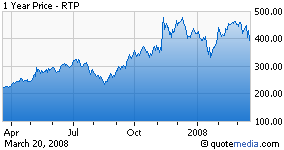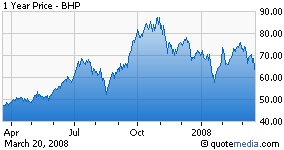“Broken Tinto” - that’s what one analyst suggests would be a good name for a combination of BHP Billiton Ltd. (BHP) and Rio Tinto PLC (RTP).
Already the world’s biggest mining and petroleum company with a market cap in the $180-billion range, Australia’s BHP would be better off on its own, says Tony Robson of BMO Capital Markets. He initiated coverage of the company with an “outperform” rating and a target of A$45 on Wednesday, but insisted that BHP is overpriced when compared to its peers and may fall if its takeover bid fails.
BMO joins RBC Capital Markets and Canaccord Adams as the Canadian firms that cover BHP, which launched the second-biggest takeover ever in February, when it was valued at nearly $150-billion. The merger would create one of the world’s largest companies with an estimated value of roughly $315-billion.
While prospects for wealth destruction remain, given the possibility of a higher bid for Rio, BHP shares are nonetheless attractive, Mr. Robson said in a report. He estimates the merged entity will make $33-billion in net profit in 2008/2009, and said BHP’s balance sheet will become stronger in the long-term, positioning the company for future “predatory actions” or a return of cash to shareholders.

 The analyst suggested that a reasonable bid for Rio would be 2.32 BHP shares for every Rio share. The most recent offer was 3.4-for-1. But if you take into account $1.7-billion in annual synergies, BMO’s estimate rises to 2.55-for-1, or 2.73-for-1 with an additional US$2-billion of annual gains indicated by BHP’s extra output.
The analyst suggested that a reasonable bid for Rio would be 2.32 BHP shares for every Rio share. The most recent offer was 3.4-for-1. But if you take into account $1.7-billion in annual synergies, BMO’s estimate rises to 2.55-for-1, or 2.73-for-1 with an additional US$2-billion of annual gains indicated by BHP’s extra output.
But BHP’s bid is destructive in terms of net present value [NPV] per share, earnings before interest, taxes, depreciation and amortization [EBITDA] and earnings per share [EPS] under a variety of commodity price scenarios, Mr. Robson said, adding that suggested synergies do not offset this dilution.